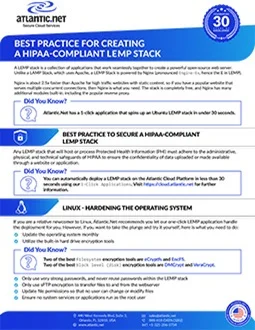Best Practice for Creating a HIPAA-Compliant LEMP Stack
This whitepaper provides a comprehensive guide to securing a LEMP stack for HIPAA compliance. It offers practical advice and best practices for configuring each component of the stack (Linux, Nginx, MySQL, PHP) to ensure the confidentiality, integrity, and availability of protected health information (PHI).
Download PDF
Get Your Free Guide
Key Topics Covered:
- Hardening the Linux Operating System: Regularly updating the OS, utilizing hard drive encryption tools, enforcing strong passwords, and restricting file permissions.
- Nginx Best-Practice Tips: Regularly updating Nginx, obfuscating server information, enforcing HTTP Strict Transport Security (HSTS), disabling deprecated SSL standards and weak cipher suites, disabling unwanted modules, and enforcing cross-site scripting (XSS) protection.
- MySQL Best Practice: Implementing data masking and de-identification routines, encrypting data at rest, enabling SELinux for access control, using plugins for authentication and access restriction, and enabling the MySQL Enterprise Audit plugin for monitoring and logging.
- PHP Best Practice: Keeping PHP up-to-date, hashing and verifying passwords, enforcing a user registration system, and protecting against cross-site scripting (XSS) and request forgery (XSFR).
Download this helpful guide to:
- Understand the importance of HIPAA compliance for LEMP stacks.
- Learn practical steps to secure each component of your LEMP stack.
- Implement best practices for data protection and access control.
- Ensure your web applications comply with HIPAA regulations.